INSTITUT SUPERIEUR D'ANTHROPOLOGIE
INSTITUTE OF ANTHROPOLOGY
ONLINE COURSES / COURS A DISTANCE
INSCRIPTION : Année Universitaire 2012/2013
REGISTRATION : Academic Year 2012 / 2013
FRANCE - 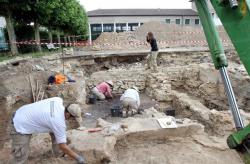 Pont à Mousson -
Pont à Mousson -
http://www.republicain-lorrain.fr/actualite/2012/08/03/sous-le-lycee-marquette-l-universite-de-lorraine
CANADA – 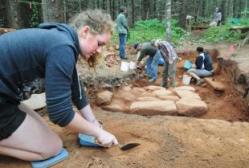 Stanhope - Archaeologists continue discovering evidence in Stanhope of early British farm homestead . An archaeological dig here continues to provide a window to Prince Edward Island's earliest days. Archaeologists are uncovering the remnants of a British farm homestead from the late 1700s in Stanhope, the site of the first British settlement on P.E.I. Towards the end of the dig in 2010, they discovered what appeared to be a cellar. This week they found something else. "There's two foundation stones sitting in there,'' said John Palmer, with the historical society, pointing to a series of stones in the cellar. "We think that's a chimney base and that goes back under (the ground) but the trees have since grown in.'' A lot of trees have grown up over the past few centuries in what used to be farmland, for which the trail was named after. All that reminds people today of the old farmland is the flat terrain.
Stanhope - Archaeologists continue discovering evidence in Stanhope of early British farm homestead . An archaeological dig here continues to provide a window to Prince Edward Island's earliest days. Archaeologists are uncovering the remnants of a British farm homestead from the late 1700s in Stanhope, the site of the first British settlement on P.E.I. Towards the end of the dig in 2010, they discovered what appeared to be a cellar. This week they found something else. "There's two foundation stones sitting in there,'' said John Palmer, with the historical society, pointing to a series of stones in the cellar. "We think that's a chimney base and that goes back under (the ground) but the trees have since grown in.'' A lot of trees have grown up over the past few centuries in what used to be farmland, for which the trail was named after. All that reminds people today of the old farmland is the flat terrain.
http://www.theguardian.pe.ca/News/Local/2012-08-02/article-3044657/Uncovering-the-truth-about-P.E.I.-history/1
ROYAUME UNI - 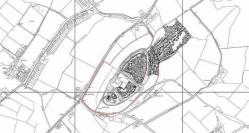 Castle Hill – Space-age technology is helping experts discover the historic past of Castle Hill. Early results of a new survey have caused excitement among archaeologists. Evidence of farming and possible fortifications has been revealed. Anyone with an interest in Castle Hill’s past can view geophysical maps – similar to X-ray images – which give an idea of what might be hidden beneath the surface. Sam Harrison, project archaeologist from the West Yorkshire Archaeological Services (WYAS) said: “In the last few weeks we have been undertaking a magnetometer and earth resistance surveys of the fort and the surrounding land. “We have identified a previous agricultural regime in the annex. The anomalies identified include a former field boundary and ploughing trends. “Closer to the fort we have identified possible ditches that may have been additional defensive earthworks.” The history of human activity on Castle Hill goes back over 4,000 years. The site was developed as an iron age hill fort, surrounded by defensive ditches and ramparts. In the Middle Ages there was a castle on the hill, of which the well remains. The present tower was built to commemorate Queen Victoria’s Diamond Jubilee of 1897.
Castle Hill – Space-age technology is helping experts discover the historic past of Castle Hill. Early results of a new survey have caused excitement among archaeologists. Evidence of farming and possible fortifications has been revealed. Anyone with an interest in Castle Hill’s past can view geophysical maps – similar to X-ray images – which give an idea of what might be hidden beneath the surface. Sam Harrison, project archaeologist from the West Yorkshire Archaeological Services (WYAS) said: “In the last few weeks we have been undertaking a magnetometer and earth resistance surveys of the fort and the surrounding land. “We have identified a previous agricultural regime in the annex. The anomalies identified include a former field boundary and ploughing trends. “Closer to the fort we have identified possible ditches that may have been additional defensive earthworks.” The history of human activity on Castle Hill goes back over 4,000 years. The site was developed as an iron age hill fort, surrounded by defensive ditches and ramparts. In the Middle Ages there was a castle on the hill, of which the well remains. The present tower was built to commemorate Queen Victoria’s Diamond Jubilee of 1897.
http://www.examiner.co.uk/news/local-west-yorkshire-news/2012/08/03/chance-to-learn-the-secrets-of-castle-hill-at-special-events-86081-31538032/2/
TURKMENISTAN - Ulug Dépé - The 2012 Archaeology Prize created by the Simone and Cino del Duca Foundation of the French Institute went to the Franco-Turkmen archaeological mission Ulug Dépé. Led by Olivier Lecomte and Julio Bendezu-Sarmiento from the CNRS (National Center for Scientific Research), since 1994 the mission of the Foundation is studying the evolution of the population in Central Asia and more precisely Turkmenistan. In collaboration with the Turkmen direction for Protection, Study and Restoration of the Turkmen historic and cultural heritage, the mission has conducted ten excavation campaigns on the Ulug Dépé site. These studies have dealt with periods ranging from the chalcolithic period to the Hellenistic era. A major Turkmenistan proto-urban site, Ulug Dépé is the only city known for its Medes period. However, research results question the birthplace of the Medes kingdom.
http://www.artmediaagency.com/en/49703/2012-archaeology-prize-awarded-to-ulug-depe-mission/
ROYAUME UNI – 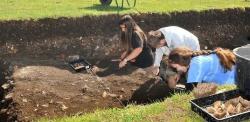 Caistor St Edmund - Archaeologists are revisiting the site of Venta Icenorum, in Caistor St Edmund, in hope of uncovering more secrets from the Roman town on the outskirts of Norwich. The excavations will begin on August 11, once again being led by Dr Will Bowden from the University of Nottingham, and lasting until September 1. Last year saw tremendous success for Dr Bowden and his team, as they focused on the forum in the site, which would have been the centre of all activity. They discovered the remnants of a group of buildings that pre-dated the forum, which would have been made of timber and clay, but there was evidence that these had been burnt down in a “catastrophic fire” before the forum had even been built. Further discoveries showed that the forum had initially been abandoned by its inhabitants, but then had been rebuilt. Parts of the site were originally excavated between 1929 and 1935 following the publication of dramatic aerial photographs showing evidence of streets and public buildings, but it was left undisturbed until Dr Bowden’s digs began three years ago. Five facts about the Roman town of Caistor St Edmund:- The town was the Romano-British predecessor of the modern county town, Norwich.- Prehistoric monuments show that before the town was built, the Venta area was already in a place of existing importance. This could be the reason why they chose to place the town here and not in Norwich, where there were greater natural resources. - All of the buildings were modestly built from timber, but in the time of Emperor Hadrian (AD 117 – 38) the public buildings became much grander. - The coins of Honorius discovered on the site suggest that in spite of the breakdown in Roman authority in AD 340s, activity continued after AD 400. Roman towns such as Venta Icenorum were built to administer the people that the Romans had conquered, and reward those who had helped to conquer them by giving them important jobs in the law courts and town councils.
Caistor St Edmund - Archaeologists are revisiting the site of Venta Icenorum, in Caistor St Edmund, in hope of uncovering more secrets from the Roman town on the outskirts of Norwich. The excavations will begin on August 11, once again being led by Dr Will Bowden from the University of Nottingham, and lasting until September 1. Last year saw tremendous success for Dr Bowden and his team, as they focused on the forum in the site, which would have been the centre of all activity. They discovered the remnants of a group of buildings that pre-dated the forum, which would have been made of timber and clay, but there was evidence that these had been burnt down in a “catastrophic fire” before the forum had even been built. Further discoveries showed that the forum had initially been abandoned by its inhabitants, but then had been rebuilt. Parts of the site were originally excavated between 1929 and 1935 following the publication of dramatic aerial photographs showing evidence of streets and public buildings, but it was left undisturbed until Dr Bowden’s digs began three years ago. Five facts about the Roman town of Caistor St Edmund:- The town was the Romano-British predecessor of the modern county town, Norwich.- Prehistoric monuments show that before the town was built, the Venta area was already in a place of existing importance. This could be the reason why they chose to place the town here and not in Norwich, where there were greater natural resources. - All of the buildings were modestly built from timber, but in the time of Emperor Hadrian (AD 117 – 38) the public buildings became much grander. - The coins of Honorius discovered on the site suggest that in spite of the breakdown in Roman authority in AD 340s, activity continued after AD 400. Roman towns such as Venta Icenorum were built to administer the people that the Romans had conquered, and reward those who had helped to conquer them by giving them important jobs in the law courts and town councils.
http://www.eveningnews24.co.uk/news/new_dig_set_to_start_at_caistor_st_edmund_roman_town_near_norwich_1_1469601
ROUMANIE – Sibiu - Several metal archeological objects and over 280 silver coins were discovered by archeologists on the track of the future Sibiu – Nadlac highway in Romania. One of the discoveries, a small iron replica of a chariot was deemed unique in the region. The objects discovered in the nine archeological sites, dating from the early Neolithic to the Medieval Ages, will most likely be restored within a year. A team of 40 Romanian and foreign archeologists searched around 40 kilometers on the future highway track in three counties, Sibiu, Alba and Hunedoara. This was one of the biggest archeological digs ever undertaken in Romania, according to Sabin Luca, director of the Brukenthal National Museum. Researchers discovered a Bronze age settlement and “the first level of colonization which could be connected to our ancestors dates from the Celtic era, in the 3rd and 2nd centuries BC,” according to Sabin Luca. The small iron chariot discovered will most likely be unique, he went on to say. In Celtic areas, the iron chariot is usually buried with the full size chariot, but in this case it was buried separately. The piece was in 80 pieces and its restoration took three weeks. The archeologists found weapons, tools, weapon tips, heels and a stash of 280 silver coins, including Ancient Greek and Roman examples. “There are hundreds of this kind of silver hoard from that period, but they are rarely found in archeological sites by researchers.
http://www.romania-insider.com/archeologists-unearth-celtic-artifacts-plus-ancient-roman-and-greek-silver-coins-on-future-track-of-romanian-highway/62275/
TURQUIE – 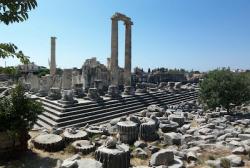 Didym - Restoration works have begun at the Apollo Temple in the Aegean province of Aydın’s Didim district. The excavation work that has been conducted in the temple for 106 years by the German Archaeology Institute was canceled this year for the storage and restoration of materials unearthed during this process. Now the work is being carried out under the leadership of Austrian Bond University member Dr. Ulf Weber. Speaking to the press, the German Archaeology Institute Apollo Temple Restorations official Helga Bumke said she had been working on the excavations since 1994 and had found thousands of pieces during the Apollo Temple and Holy Road excavations.
Didym - Restoration works have begun at the Apollo Temple in the Aegean province of Aydın’s Didim district. The excavation work that has been conducted in the temple for 106 years by the German Archaeology Institute was canceled this year for the storage and restoration of materials unearthed during this process. Now the work is being carried out under the leadership of Austrian Bond University member Dr. Ulf Weber. Speaking to the press, the German Archaeology Institute Apollo Temple Restorations official Helga Bumke said she had been working on the excavations since 1994 and had found thousands of pieces during the Apollo Temple and Holy Road excavations.
http://www.hurriyetdailynews.com/